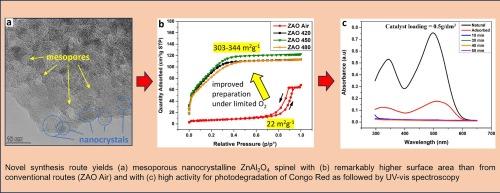合成具有优异光催化活性的高比表面积介孔 ZnAl2O4,用于光降解刚果红染料
IF 6.5
1区 化学
Q2 CHEMISTRY, PHYSICAL
引用次数: 0
摘要
纺织业和其他行业向水道中大量排放有机染料,使水生环境恶化,给野生动物、人类和家畜带来严重的健康问题。因此,从废水中去除此类染料是一项紧迫而重要的挑战。利用阳光对这些染料进行高效的光催化破坏是一种优雅而有吸引力的潜在解决方案。本研究采用改良的溶胶-凝胶合成工艺制备了具有高比表面积、高孔隙率和均匀孔径分布的介孔 ZnAl2O4 纳米材料。BET 分析表明,ZnAl2O4 的最高比表面积达到 344 m2/g。利用 XRD、FTIR、TEM、EDS、CHN 和 XPS 分析以及 zeta 电位测量进一步研究了这些材料的质地、结构和化学成分。从紫外/可见光谱中获得的带隙能表明,随着粒度的减小,带隙能显著减小,最细的材料将吸收转移到可见光范围,这表明这些材料具有在太阳照射下提高光催化效率的潜力。通过研究刚果红染料的光降解,对光催化活性进行了评估,结果表明,最好的材料在 30 分钟内就降解了 99% 的染料。这些结果与之前报告的研究结果相比非常理想。利用质谱法对刚果红的降解产物进行了进一步研究,这项详细研究证实,染料分子确实在光诱导下发生了碎裂,而不是简单的 "光漂白"。本文章由计算机程序翻译,如有差异,请以英文原文为准。

Synthesis of high surface area mesoporous ZnAl2O4 with excellent photocatalytic activity for the photodegradation of Congo Red dye
The large-scale release by the textile and other industries of organic dyes into water courses degrades the aquatic environment and results in serious health problems for wildlife, humans, and domestic animals. The removal of such dyes from wastewater is therefore a pressing and important challenge. The efficient photocatalytic destruction of these dyes using sunlight is an elegant and attractive potential solution. In this work, mesoporous ZnAl2O4 nanomaterials were prepared with high specific surface area, high pore volume and uniform pore size distribution using a modified sol–gel synthetic protocol. BET analysis showed that the highest surface area achieved for ZnAl2O4 reached 344 m2/g. The texture, structure and chemical composition of these materials were further studied using XRD, FTIR, TEM, EDS, CHN and XPS analysis and zeta potential measurements. Band gap energies were obtained from UV/vis spectra and showed a strong decrease as particle size decreased, shifting absorption into the visible range for the finest materials and indicating the potential to improve the efficiency of photocatalysis under solar irradiation. Photocatalytic activity was evaluated by studying the photodegradation of Congo Red dye and, for the best materials, showed that 99 % of the dye was degraded in only 30 mins. These results compared very favourably with those of previously reported studies. The degradation products of the Congo Red were further investigated using mass spectrometry and this detailed study confirmed that true photoinduced fragmentation of the dye molecule occurred rather than simple ‘photobleaching’.
求助全文
通过发布文献求助,成功后即可免费获取论文全文。
去求助
来源期刊

Journal of Catalysis
工程技术-工程:化工
CiteScore
12.30
自引率
5.50%
发文量
447
审稿时长
31 days
期刊介绍:
The Journal of Catalysis publishes scholarly articles on both heterogeneous and homogeneous catalysis, covering a wide range of chemical transformations. These include various types of catalysis, such as those mediated by photons, plasmons, and electrons. The focus of the studies is to understand the relationship between catalytic function and the underlying chemical properties of surfaces and metal complexes.
The articles in the journal offer innovative concepts and explore the synthesis and kinetics of inorganic solids and homogeneous complexes. Furthermore, they discuss spectroscopic techniques for characterizing catalysts, investigate the interaction of probes and reacting species with catalysts, and employ theoretical methods.
The research presented in the journal should have direct relevance to the field of catalytic processes, addressing either fundamental aspects or applications of catalysis.
 求助内容:
求助内容: 应助结果提醒方式:
应助结果提醒方式:


